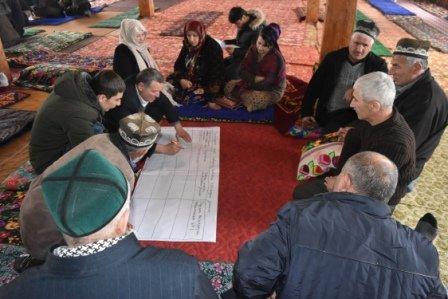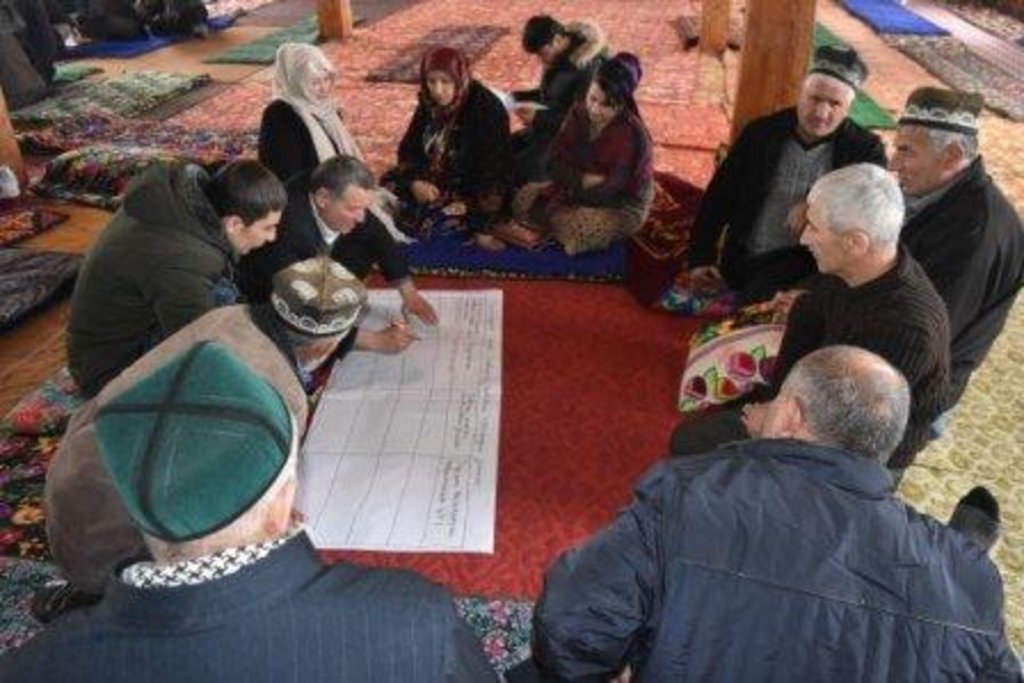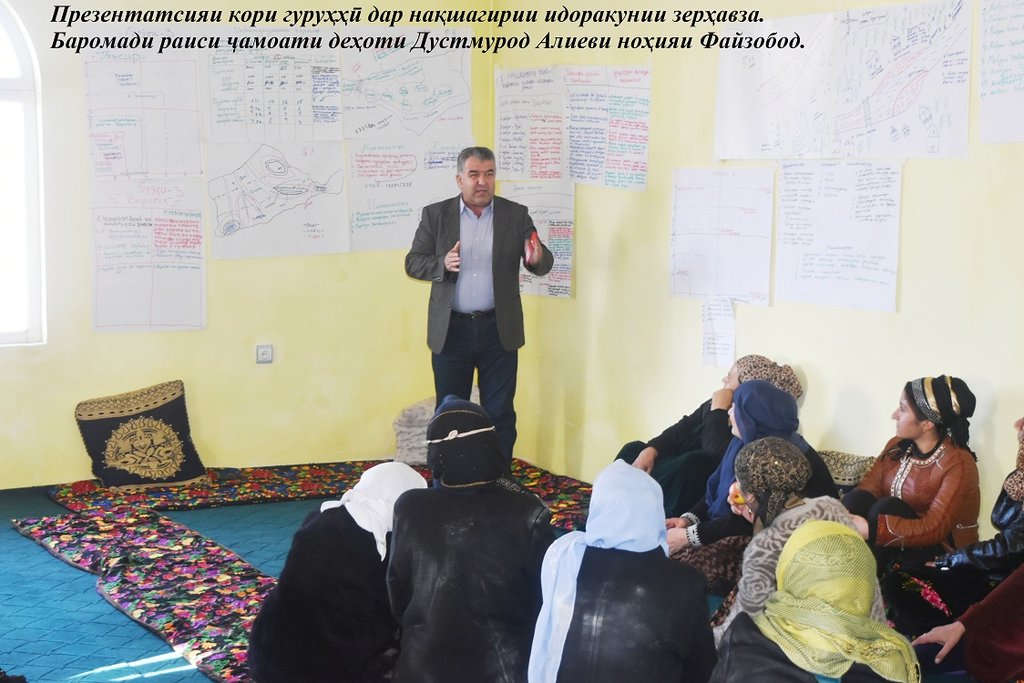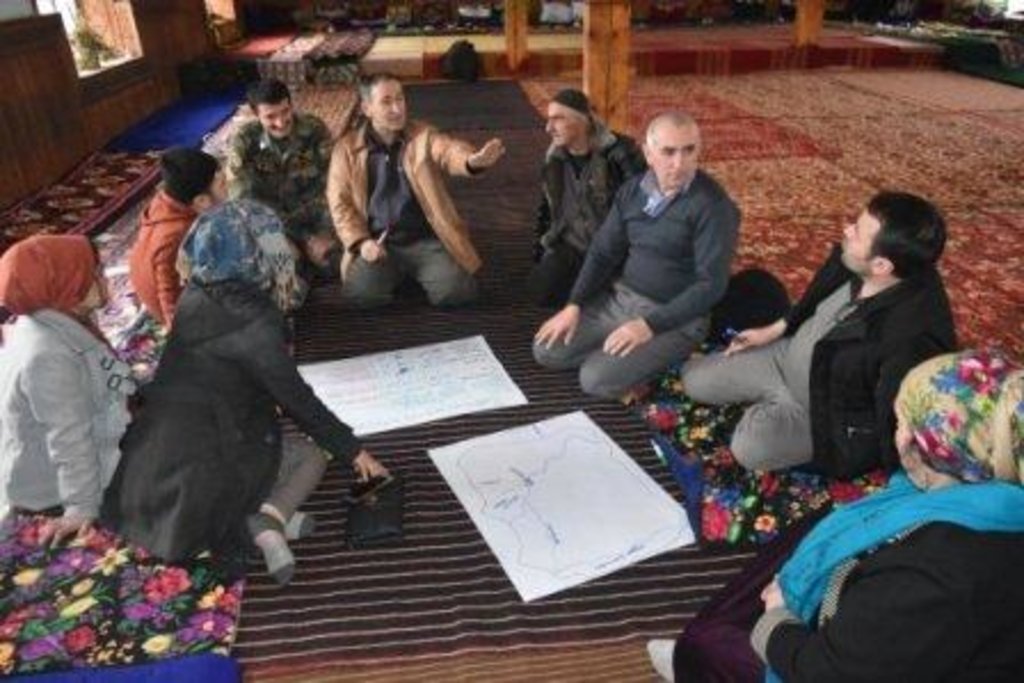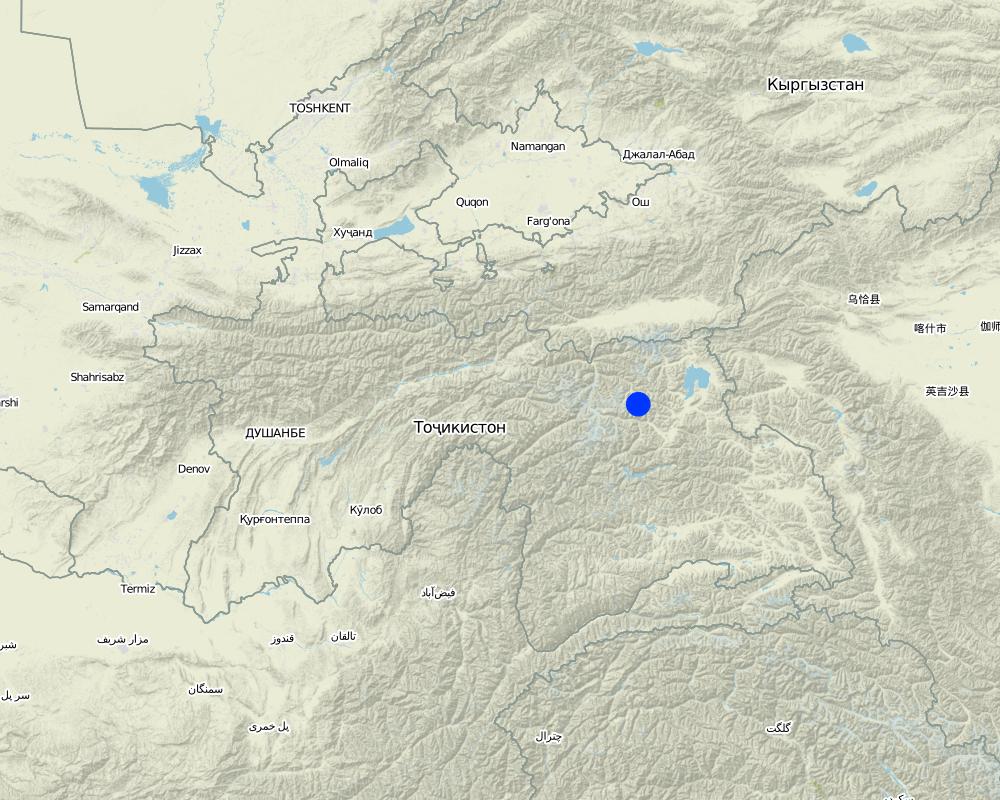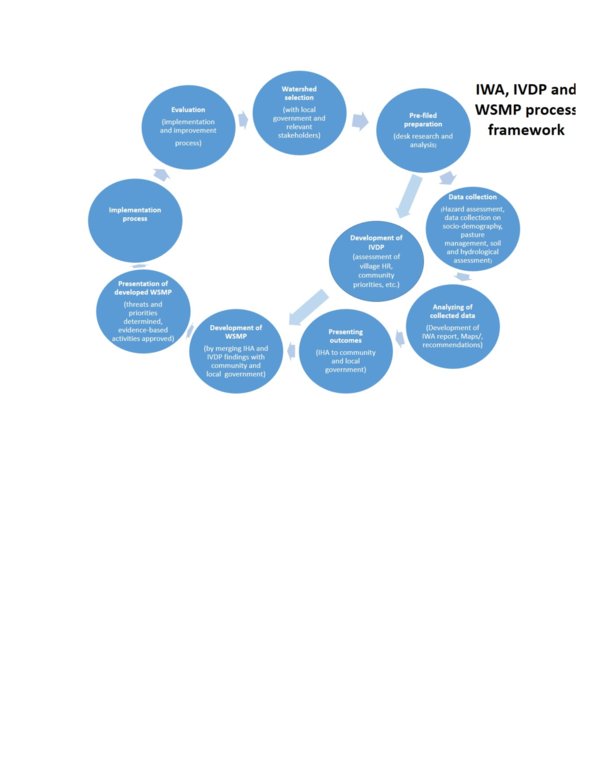Resilient Watershed Management Plan [طاجيكستان]
- تاريخ الإنشاء:
- تحديث:
- جامع المعلومات: Askarsho Zevarshoev
- المحرر: –
- المُراجع: Farrukh Nazarmavloev
Идоракуни Хавза
approaches_3612 - طاجيكستان
عرض الأقسام
توسيع الكل طي الكل1. معلومات عامة
1.2 تفاصيل الاتصال بالأشخاص الرئيسيين لمصدر المعلومات والمؤسسات المعنية بتقييم وتوثيق النهج
اسم المشروع الذي سهّل توثيق/تقييم النهج (إذا كان ذلك على صلة)
Integrated Health and Habitat Improvement in Rasht Valley, Tajikistanاسم المؤسسة (المؤسسات) التي سهلت توثيق/تقييم النهج (إذا كان ذلك على صلة)
Aga Khan Foundation (AKF) - سويسرا1.3 الشروط المتعلقة باستخدام البيانات الموثقة من خلال WOCAT
متى تم تجميع البيانات (ميدانيا)؟:
21/02/2018
يوافق جامع المعلومات والشخص (لاشخاص) الرئيسي لمصدر المعلومات على الشروط المتعلقة باستخدام البيانات الموثقة من خلال WOCAT:
نعم
1.4 المراجع الخاصة باستبيان(استبيانات) تقنيات الإدارة المستدامة للأراضي
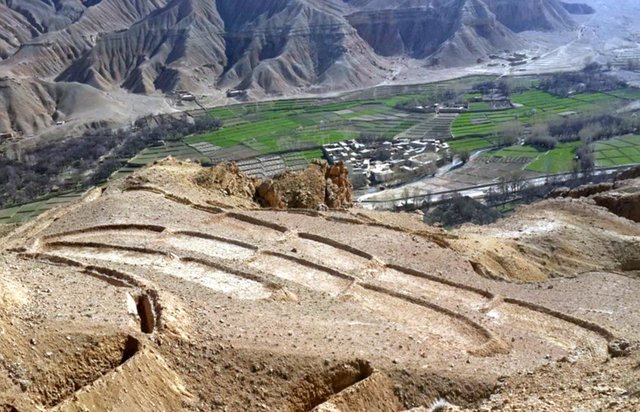
Terracing in Watershed [أفغانستان]
Reshaping unproductive land into a series of levelled, gently-sloping platforms creates conditions suitable for cultivation and prevents accelerated erosion.
- جامع المعلومات: Aqila Haidery
2. وصف نهج الإدارة المستدامة للأراضي
2.1 وصف موجز للنهج
The participatory watershed management plan (WMP) is an interdisciplinary approach at community level to raise awareness on the watershed management concept and improve understanding of the watershed approach in planning and management of natural resource.
2.2 وصف تفصيلي للنهج
وصف تفصيلي للنهج:
In the participatory WMPs, the main emphasis is placed on identifying critical factors (or so called thresholds) in the sub-watershed and identifying management actions to reduce the potential of negative effects of these factors on the sub-watershed ecosystems and livelihoods. In the process of participatory WMP stakeholders will identify factors that people can control and factors they cannot control. The planning is different for factors that people can control (mitigation of risk factors), for instance sustainability measures of access to safe and clean drinking water, and factors they cannot control (adaptation to risk factors), for instance melting of glaciers and formation of risk-posing glacial lakes.
In WMPs stakeholders collaborate with the technical team to incorporate key findings of the Integrated Habitat Assessment (IHA). To enhance community ownership and participation in the implementation of local development plans, communities and local authorities will be fully involved in the identification, implementation, and handover of the planning process and intervention implementations.
Based on the action plan developed as a result of participatory WMPs, interventions will be implemented to regenerate, protect, or enhance land/resource conditions in the different parts of each sub-watershed in a holistic manner in line with the IWSM approach. Projects at the village level will be identified based on the village management plan and projects operating at the sub-watershed or multi-village level will be informed by WMPs. The resilient NRM activities will be designed to specifically contribute to the improved land use and stabilization of degraded areas in the sub-watershed. During design, protection and synergies will be considered with socio-economic development project.
The WMPs will be prepared for the purpose of enhancing communities’ sustainable development through building capacities and capabilities of local communities to manage and reduce risks from natural hazards, to improve natural resources management, land use planning and pasture management. To conduct the WMP process, a working group will be established at the sub-watershed level, which will include the head of the jamoat(s), representatives from relevant district government departments (Land Management, Geology, Agriculture, Environmental Protection), and representatives from local community based organizations.
The preparation process of the WMPs will be closely coordinated and consulted with the community based organizations as well as local governments with plans conducted at the sub-watershed level. It is tentatively planned that ownership of the plans will fall to either the jamoat government (if a sub-watershed covers only one jamoat) or the district government (in the case of sub-watersheds covering more than one jamoat). However, the ownership model and other aspects of WMP process is still not clear and should be piloted in a different scenario. The WMPs will enable the target sub-watersheds to make comprehensive planning and take into account socio-economic, disaster management, and natural resources management aspects.
As a result of this process, three WMPs were developed at three sub-watershed level in Rasht Valley of Kuksu, Surkhdara and Nushor sub-watersheds. As a result the watershed committee was supported with implementation of interventions, where immediate action was required to prevent further degradation. For example in the Nushori bolo sub-watershed in consultation with government and community mobilization it was agreed to ban grazing in the most degraded upper zone of the pasture, which had also a risk of landslide. In a short period after limiting grazing the pasture areas in the upper zone of watershed started to rehabilitate.
2.3 صور عن النهج
ملاحظات عامة بخصوص الصور:
The head of the local government at the sub-district area which represents the selected watershed is presenting the agreed action plan to all stakeholders. The head of the local government is also a member of the working group on sub-watershed management together with the chairman and land use committee, environmental protection, forestry department.
2.5 البلد/المنطقة/المواقع التي تم تطبيق النهج فيها
البلد:
طاجيكستان
المنطقة/الولاية/المحافظة:
Sub-ordinate regions
مزيد من التفاصيل حول الموقع:
Rasht Valley, Faizobod District
Map
×2.6 تواريخ بدء وإنهاء تنفيذ النهج
في حالة عدم معرفة السنة بالتحديد، يرجى الإشارة إلى التاريخ التقريبي لبدء النهج:
منذ أقل من 10 سنوات (مؤخرًا)
2.7 نوع النهج
- قائم على مشروع/برنامج
2.8 الغايات/الأهداف الرئيسية للنهج
Improvement of natural resource management and prevention of natural hazards as a result of unsustainable use of natural resource.
2.9 الظروف التي تمكن أو تعيق تنفيذ التقنية/التقنيات المطبقة بموجب النهج
المعايير والقيم الاجتماعية /الثقافية/ الدينية
- معيق
the sub-watershed covers several communities, where each community has its own management structure with social and cultural norms. sometimes the social and cultural norms in each communities do not agree with each other because of these different norms and interests.
توفر/الوصول إلى الموارد والخدمات المالية
- تمكين/تمكيني
the WMPs, which contains detail aspect of use on different land categories it attracts attention from different funders, including donors and government. in the framework of the project special fund was allocated fro implementation of the designed actions and interventions. This allowed land users and land specialist to implement several planned measures
الإطار المؤسساتي
- معيق
In the framework of this approach no legal institute exists to own the WMP
التعاون/التنسيق بين الجهات الفاعلة
- تمكين/تمكيني
entails different categories of land use, which involves collaboration among different agencies and land users
الإطار القانوني (حيازة الأراضي، وحقوق استخدام الأراضي والمياه)
- معيق
there is not official institute, which is dedicated to watershed management. Therefore ownership of the plan is hindering further implementation after the project ends
حوكمة الأراضي (صنع القرار والتنفيذ والإنفاذ)
- تمكين/تمكيني
The approach brings different local institutes, which are in charge of different natural resources together. This will enable an integrated approach to the natural resource management, as all of them are brought under one action plan.
المعرفة حول الإدارة المستدامة للأراضي، والوصول إلى الدعم الفني
- تمكين/تمكيني
The approach focuses on different SLM practices and sharing knowledge from different expertice
عبء العمل، توفر القوى العاملة
- معيق
High volume of migration of youth outside the area and high demand for labour force is hindering the process.
3. المشاركة وأدوار الأطراف المعنية
3.1 أصحاب المصلحة المعنيون بالنهج وأدوارهم
- مستخدمو الأراضي المحليون/المجتمعات المحلية
community members - farmers, livestock owners, forest owners
As first level of land users they are responsible for overall management of the natural resource and its conservation.
- الباحثون
researches - pasture specialist, geobotanics, soil specialist, hydrologist
are involved in technical assessment of the resources and support communities integration of findings into their plan
- المعلمون / أطفال المدارس / الطلاب
teachers on natural sciences and secondary school management
participate in the awareness raising session and support with knowledge sharing with schoolchildren, also use the new knowledge during classes.
- منظمة غير حكومية
MSDSP Mountain Societies Development Support Programme
mobilization of stakeholders in development of their participatory plans
- الحكومة المحلية
all departments on natural resources management - land, forest, water, pasture
controlling, supervision and mainstreaming the new approach into their working plan
3.2 انخراط مستخدمي الأراضي المحليين/المجتمعات المحلية في المراحل المختلفة للنهج
| انخراط مستخدمي الأراضي المحليين/المجتمعات المحلية | حدد من شارك وصف الأنشطة | |
|---|---|---|
| المبادرة/التحفيز | الدعم الخارجي | supported by external consultants to provide feedback on the overall approach |
| التخطيط | تفاعلي | participatory approach is applied to develop the plan jointly with the land users |
| التنفيذ | التعبئة الذاتية | after the plan is developed and their awareness is raised they take initiative to implement the designed interventions. |
| الرصد/التقييم | تفاعلي | the project team jointly with the community members and working group established at the sub-watershed level conducted the monitoring. The working group, which consist of the project team and governmental officials have good knowledge on monitoring skills. |
3.3 مخطط التدفق (إذا كان متاحًا)
الوصف:
The watershed management circle including the whole circle of the planning process, starting from watershed selection up to evaluation.
المؤلف:
Zevarshoev Askarsho
3.4 اتخاذ القرار بشأن اختيار تقنية/تقنيات الإدارة المستدامة للأراضي
حدد من الذي قرر اختيار التقنية/التقنيات التي سيتم تنفيذها:
- جميع الجهات الفاعلة ذات الصلة، كجزء من نهج تشاركي
اشرح:
The plan is developed in a participatory way, so everybody is suggesting and participating in the decision making.
حدد على أي أساس تم اتخاذ القرارات:
- تقييم المعرفة الموثقة جيدًا بشأن الإدارة المستدامة للأراضي(اتخاذ القرارات القائمة على الأدلة)
4. الدعم الفني وبناء القدرات وإدارة المعرفة
4.1 بناء القدرات/التدريب
هل تم تقديم التدريب لمستخدمي الأراضي / الأطراف المعنيين الآخرين؟:
نعم
حدد من تم تدريبه:
- موظفون ميدانيون/ مستشارون
إذا كان ذلك على صلة، حدد الجنس والعمر والوضع والعرق وما إلى ذلك.
women and man, 50-55, local people
شكل التدريب:
- دورات
المواضيع المغطاة:
Watershed Management
4.2 خدمة استشارية
هل يملك مستخدمو الأراضي وصولا إلى خدمة استشارية؟:
كلا
4.3 تعزيز المؤسسات (التطوير التنظيمي)
هل تم إنشاء أو تعزيز مؤسسات من خلال هذا النهج؟:
- نعم، قليلا
حدد المستوى (المستويات) التي تم فيها تعزيز أو إنشاء المؤسسات:
- محلي
صف المؤسسة والأدوار والمسؤوليات والأعضاء وما إلى ذلك.
local level working group had been established to become owner of the watershed management plan. at the moment the working groups is unofficial and agreed to take of the plan implementation until the official structure is established
حدد نوع الدعم:
- بناء القدرات/التدريب
اعط مزيدا من التفاصيل:
trainings for community on watershed management, pasture and land management was conducted
4.4 الرصد والتقييم
هل يشكل الرصد والتقييم جزءا من النهج؟:
كلا
4.5 البحوث
هل كانت البحوث جزءًا من النهج؟:
كلا
5. التمويل والدعم المادي الخارجي
5.1 الميزانية السنوية لمكون الإدارة المستدامة للأراضي في النهج المذكور
إذا لم تكن الميزانية السنوية الدقيقة معروفة، قم بالإشارة إلى نطاقها:
- 100,000-10,000
التعليقات (على سبيل المثال المصادر الرئيسية للتمويل/الجهات المانحة الرئيسية):
The implementation of the plan is depending on the size of the watershed and the condition to which extent it is degraded and requires rehabilitation measures.
5.2 الدعم المالي/المادي المقدم لمستخدمي الأراضي
هل حصل مستخدمو الأراضي على دعم مالي/ مادي لتنفيذ التقنية/ التقنيات؟:
كلا
5.3 إعانات لمدخلات محددة (بما في ذلك العمالة)
- غير موجود
إذا كان العمل من قبل مستخدمي الأراضي مدخلاً جوهريًا، فهل كان:
- تطوعي
5.4 الائتمان
هل تم توفير ائتمان في إطار نهج أنشطة الإدارة المستدامة للأراضي؟:
كلا
5.5 حوافز أو وسائل أخرى
هل تم استخدام حوافز أو أدوات أخرى لتشجيع تنفيذ تقنيات الإدارة المستدامة للأراضي؟:
نعم
إذا كانت الإجابة بنعم، حدد:
Certain amount of funding was made available in the first phase to implement part of the action plan under the Watershed Management Plan
6. تحليل الأثر والتصريحات الختامية
6.1 آثار النهج
هل ساهم النهج في تمكين مستخدمي الأراضي المحليين وتحسين مشاركة الأطراف المعنية؟:
- لا
- نعم، قليلا
- نعم، باعتدال
- نعم، إلى حد كبير
community members were fully involved in the planning process and participated in decision making with regards to interventions. in addition community members were selected to become member of working groups, which have the opportunity to participate in the overall management of the watershed
after development the plan community were supported with implementation of several intervention specific to each watershed to see the effects
هل أدى النهج إلى تحسين معرفة وقدرات مستخدمي الأراضي على تنفيذ الإدارة المستدامة للأراضي؟:
- لا
- نعم، قليلا
- نعم، باعتدال
- نعم، إلى حد كبير
the approach leads to the development of action plan with the expertise from SLM experts where different technologies are applied as a result of implementation of the actions related to watershed improvement
هل أدى النهج إلى تحسين معرفة وقدرات الأطراف المعنية الأخرى؟:
- لا
- نعم، قليلا
- نعم، باعتدال
- نعم، إلى حد كبير
it involves also capacity building of the stakeholders and improves their awareness on the watershed management approach
هل أدى النهج إلى تحسين المساواة بين الجنسين وتمكين النساء والفتيات؟:
- لا
- نعم، قليلا
- نعم، باعتدال
- نعم، إلى حد كبير
It brings all stakeholders together to make decision with agreement with each other. women and girls also participated actively at the community planning process and were involved in the decision making
هل شجع النهج الشباب/الجيل القادم من مستخدمي الأراضي على الانخراط في الإدارة المستدامة للأراضي؟:
- لا
- نعم، قليلا
- نعم، باعتدال
- نعم، إلى حد كبير
in the implementation process of intervention mainly were involved youth jointly with technical project team, NRM specialist and bio-soil engineering and had a chance to learn new technologies and skills
in the implementation process jointly with project experts, including NRM specialist and bio-soil engineer different SLM technologies were implemented at the sub-watershed level
هل أدى النهج إلى تحسين قدرة مستخدمي الأراضي على التكيف مع التغيرات المناخية/الظواهر المناخية المتطرفة والتخفيف من الكوارث المرتبطة بالمناخ؟:
- لا
- نعم، قليلا
- نعم، باعتدال
- نعم، إلى حد كبير
beside overgrazing, heavy precipitation in the last years have exacerbate the pasture degradation. through introducing new measures this contribute to minimize the effect of the heave precipitation, which is the cause of climate change.
هل أدى النهج إلى توفير فرص عمل ودخل؟:
- لا
- نعم، قليلا
- نعم، باعتدال
- نعم، إلى حد كبير
it only enable stakeholders and land users with improvement of land use and disaster protection
6.2 المحفز الرئيسي لقيام مستخدمي الأراضي بتنفيذ الإدارة المستدامة للأراضي
- الحد من تدهور الأراضي
In the long run the plan improves the land degradation by applying different methods and environmental protection measures.
- الحد من مخاطر الكوارث
In most of the cases the forms of land use which lead to disasters were banned in order to rehabilitate the area. Different technologies were applied to reduce disaster risks.
- القواعد واللوائح (الغرامات) / الإنفاذ
The approach focuses on improving the regulation on natural resource use in the watershed context as well as setting up common rules among different stakeholders to protect land.
6.3 استدامة أنشطة النهج
هل يمكن لمستخدمي الأراضي المحافظة على استدامة ما تم تنفيذه من خلال النهج (بدون دعم خارجي)؟:
- غير مؤكد
إذا كان الجواب لا أو غير متأكد، حدد ذلك وعلق عليه:
There is no legally registered entity who owns the plan as a result of the approach, otherwise the working group is consisting of governmental representatives and community members to manage the plan
6.4 نقاط قوة/مزايا النهج
| نقاط القوة/ المزايا/ الفرص من وجهة نظر مستخدمي الأراضي |
|---|
| developed in participatory manner, involved in decision making |
| نقاط القوة/ المزايا/ الفرص من وجهة نظر جامع المعلومات أو غيره من الاشخاص الرئيسيين لمصدر المعلومات |
|---|
| represented by all parties involved in managing and using natural resource in the context of watershed |
| if legalized and owned by special entity can highly contribute to the improvement of natural resource conditions |
| could be replicated to other part/watershed as capacity on development of the approach is already built in the area |
6.5 نقاط الضعف/ العيوب في المنهج وطرق التغلب عليها
| نقاط الضعف/ المساوىء/ المخاطر من وجهة نظر جامع المعلومات أو غيره من الاشخاص الرئيسيين لمصدر المعلومات | كيف يمكن التغلب عليها؟ |
|---|---|
| absence of ownership interest over the plan developed as a result to the approach |
7. المراجع والروابط
7.1 طرق جمع/مصادر المعلومات
- مقابلات مع مستخدمي الأراضي
13
- مقابلات مع المتخصصين/الخبراء في الإدارة المستدامة للأراضي
4
- التجميع من التقارير والوثائق الأخرى الموجودة
1
7.2 المراجع للمنشورات المتاحة
العنوان، المؤلف، السنة، النظام القياسي الدولي لترقيم الكتب ISBN:
Zevarshoev Askarsho
متاح من أين؟كم التكلفة؟:
free, available upon request
7.3 روابط للمعلومات ذات الصلة المتوفرة على الإنترنت
العنوان/الوصف:
Zevarshoev Askarsho/Resilient Watershed Management Methodology
عنوان الرابط URL:
available upon request
الروابط والوحدات المواضيعية
توسيع الكل طي الكلالروابط

Terracing in Watershed [أفغانستان]
Reshaping unproductive land into a series of levelled, gently-sloping platforms creates conditions suitable for cultivation and prevents accelerated erosion.
- جامع المعلومات: Aqila Haidery
الوحدات المواضيعية
لا يوجد وحدات مواضيعية


